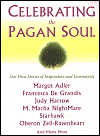
I’m wary of inspirational books. My jaded eye inspects these little wonders of pop-fiction and pseudo-nonfiction for soccer moms, and tosses them aside, forever on a quest for some idea, some piece of writing, some clip of film, some defining incident that moves me. Rarely, if ever, am I moved. I’m impervious. The emotional has been so abused in modern literature, even in some Pagan literature, that I largely ignore it in favor of some intellectual pursuit. When I practically jumped up and down waving my hands requesting this book for review, I thought it might be some chapter-by-chapter exposition of modern Paganism a la Phoenix from the Flame and I was surprised to find a more “chicken soup-esque” book in my overeager hands instead. With fresh trepidation, I opened up the book and began my journey, bracing myself for the “Wicca” soccer mom’s sentimental outlook. Instead, I found a shining gem, and some of the best Pagan writing I have ever read. These contributors are no soccer moms and dads from a Pagan Rockwell painting. These are real people, living the Pagan religions with life and grit. I might even reread favorite anecdotes, comforting myself after a trying meditation on a winter’s night. This time, I’m moved.
Wildman deserves profuse thanks for her adept assembly of these stories. The quality of assembly in this narrative series sets it apart from similar books for other religions. There really is nothing else like it currently lining bookstore shelves in the New Age section. Pagan Soul is not the gross capitalization of Hot Chocolate for the Mystic’s Soul nor is it the dryly researched survey of Drawing Down the Moon. The book is readable, incredibly well-written by each of its contributors, and edited and ordered with thought, care and sensibility.
These are no silly, manipulative tales jerking tears from my eyes or a laugh from my throat. These are tales of real people living real lives, having real experiences that make sense within a spiritual context. These are stories of smart people making stupid mistakes, and about neighbors learning to live side by side even as their religious paradigms diverge. While a good rule for writers is that it’s not important to relate to the audience, the audience, or in this case, the neopagan reader, can certainly relate.
The personal essays all tell of magic in actual practice and daily living. These personal stories tell of bitter miscarriages, loves tortured beyond death and lessons our children learn about the elements and nature. Whether sublime or sorrowful, each and every story captures one of many refractions of the rainbow of Pagan life, and tells us that Pagan living is not easy living but it is certainly a rich life. That’s not to say that this book is for “everypagan.” The only contributors shown in this book were all neopagans, largely of the Wiccan or hedgewitch ilk. Reconstructionists may or may not be able to relate to the visions and stories held within. That said, the wealth and depth of these vignettes makes this book worth having, and reading again and again.
~review by Diana Rajchel
by Laura Wildman
Citadel Press, 2005
pp. 254, $12.95
